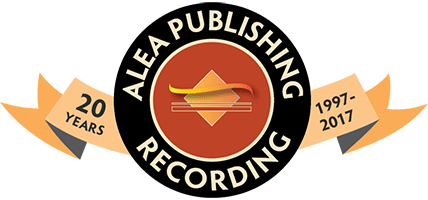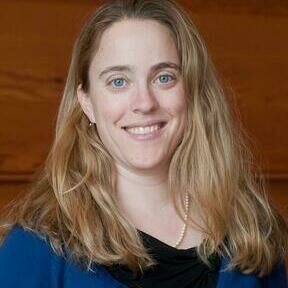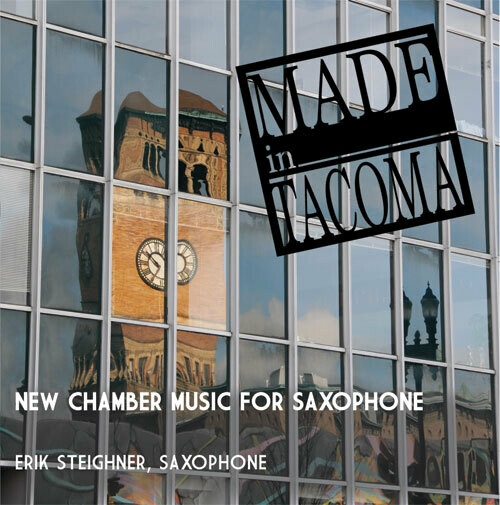

Welcome!
This site is home to Alea Publishing & Recording, specializing in music for the bass clarinet.
We offer a growing catalog of creative, artistic transcriptions and new works for bass clarinet solo & ensemble.
Made in Tacoma: New Chamber Music for Saxophone
For a physical CD, add to your cart here! To purchase downloads of the complete album or individual tracks, visit Bandcamp.
This album is also available on streaming services such as Spotify and Apple Music.
Program Notes
Calypso for solo alto saxophone
Calypso for solo alto saxophone takes us on a journey through time exploring the variety of Caribbean rhythms related to Trinidadian Calypso - from the pure rhythmic beat of drums, through the various eras of Carnival songs - kalenda, calypso and beyond. Alternately primal, lyrical or sultry, the piece uses a variety of evocative extended techniques.
-Gregory Youtz
As a Lily among Brambles for baritone saxophone and piano
Historians note that Song of Songs (also called the Song of Solomon or Canticles) closely resembles Egyptian love poetry of its time. Its authorship is under question, and ambiguity in the linguistic data prevents any exact dating of the work - anywhere between Solomon's reign (tenth century B.C.E.) and several hundred years later. My music reflects the lyric nature of the poetry, and several lines of text from the Song of Songs inspire each movement:
I. "I am a rose of Sharon, a lily of the valleys. As a lily among brambles, so is my love among maidens. As an apple tree among the trees of the wood, so is my beloved among young men." This movement uses long melodic lines to express the imagery of the two lovers' praise for each other.
II. "Make haste, my beloved, and be like a gazelle or a young stag upon the mountain of spices." A faster tempo, bolder jumps between notes, and a series of quick runs characterize this movement.
III. "You have ravished my heart, my sister, my bride. I am my beloved's and he is mine." The music reflects the delicate nature of the dialogue between the two lovers.
-Deborah Anderson
Duet for Keys and Valves for soprano saxophone and piano
I. Vertical uses the soprano saxophone's virtuosity to express an invitation, with the trumpet lending its support.
II. Horizontal takes a more introspective view, calling upon the potential of sensuality of the trumpet, with the sax as support.
III. Take It and Run came in a flash of inspiration; I had originally planned only two movements.
The title grew out of a philosophical conversation, in which it was decided that we don't always receive what we want in life, but we are often given countless other opportunities, and sometimes we need to simply take them and run with them! The music conveys a sense of adrenaline, friendly competition, and sheer fun and mischief.
-Deborah Anderson
Note: This recording reflects the original version of Duet for Keys and Valves, to which several small changes have been made in the published version.
Blues and Rhythm Changes for alto saxophone and bassoon
I've often thought of writing a piece like this. Usually, it's when I've heard yet another masterpiece by Bach and I'm struck by the use of common harmonic patterns and familiar singing instrumental lines (or "licks" in jazz terminology) that Bach seems to use in several pieces. After starting a more "classical" composition for alto sax and bassoon, I returned to an earlier idea of writing short jazz pieces. The first movement, Blues, follows blues form and is based on the interval of a fourth. The second movement, Rhythm Changes, follows the chord progression from George Gershwin's "I Got Rhythm" and is based on the interval of a third.
-Robert Hutchinson
Dance Album for saxophone trio
Dance Album started to formulate after reading a collection of essays by Susanne K. Langer. Many of Langer's essays deal with the symbology of artistic forms. Specifically, she talks about the "dynamic image": the result of translating an inward concept (be it emotions, ideas or other intangible objects) to a physical manifestation of the inward concepts. Normally music is written for a particular dance, but this idea prompted me to write music that had motions and contours inspired by dance movements. Essentially, I was re-translating the physical movements of dancers into pure music. Harmonies are sometimes left to "fall where they land" and are inspired by Ernö Lendvai's analysis of Béla Bartók.
-Jeff Tecca
Trio for tenor saxophone and percussion
Trio for tenor saxophone and percussion started as a musical portrait of someone facing the immanent experience of becoming a soldier, going off to an unknown destination, and the circumstances that came afterwards. Each of the four movements describes different aspects of this: I. Introduction depicts musically some of the excitement, anticipation, and also foreboding at the thought of what's about to happen. The 16th note drum patterns and some of the saxophone's half step motifs hopefully portray this feeling. II. Tour depicts a slightly comical scene in which the new arrival is "shown around." In III. Interlude (percussion only) the truth is penetrating - a realization and reflection on the bleakness of war. IV. Flight represents a hasty departure - in perhaps improvised conditions. The saxophonist represents a kind of protagonist, but all players are equally important in illustrating the musical picture.
-Clement Reid
Rondo à la Banjo for saxophone trio
Rondo à la Banjo was written to be a lighthearted showpiece. The work's slow introduction and main melody are both based on sections of a solo etude I composed several years ago. These materials were combined with rolls and licks associated with bluegrass banjo music like that of Earl Scruggs. The work follows a loose rondo form in which each episode presents a slightly more adventurous variation of the original thematic material.
-Erik Steighner
Composer Bios
Deborah J. Anderson grew up in Tacoma where she studied piano and voice; in college she majored in languages. She served in the Peace Corps (Tunisia) where she taught English and studied Arabic music, later returning to Seattle to earn a master's degree in French. Deborah taught at the college level for a number of years, and from 2000 to 2011 sang in the PLU Choral Union. Deborah's compositions range in setting from solo voice and choir to instrumental ensembles, solo works, duets, and concert band. Her work is performed throughout the United States as well as internationally.
Robert Hutchinson, Professor of Music Theory and Composition at the University of Puget Sound, earned his PhD from the University of Oregon, a Master of Music degree from Northern Arizona University, and a Bachelor of Arts degree from California State University Bakersfield. His music has been performed by the Charleston Symphony Orchestra; the Northwest Sinfonietta; the Tacoma Concert Band; the Tacoma Youth Symphony; the orchestra, wind ensemble, and Adelphian Concert Choir at the University of Puget Sound; and by wind ensembles and symphonic bands at the University of Akron, Central Washington University, the University of Central Oklahoma, the University of Oregon, the University of Colorado, and Oklahoma City University.
Clement Reid has written vocal, orchestral, chamber, and wind ensemble works, as well as educational books for guitar, piano, and composition. A graduate of the Eastman School of Music and the University of Southern California, his music has been performed and featured on radio broadcasts and concerts in the United States, Europe, Canada, and China. He served as panelist for the Artist Trust Foundation, has won ASCAP awards, the Sernoffsky Composition Prize, was a 2013 semi-finalist for the American Prize in Composition, and was chosen as Washington State Commissioned Composer of the Year (1999) by the Music Teachers National Association.
Jeff Tecca graduated with a bachelor's degree in music (emphasis in composition) from Pacific Lutheran University in 2010. He studied composition with Gregory Youtz and Aaron English and saxophone with Erik Steighner and Robert Miller. Tecca lives in Seattle, Washington and is currently working on a piano sonata. Many of his works are for saxophone, but he has also composed for wind band, organ, piano and small ensembles.
Gregory Youtz received his Doctorate in Music Composition from the University of Michigan in 1987. His compositions include symphonies, operas, and numerous works for orchestra, wind ensemble, choir, and chamber ensembles. Youtz is a life-long traveler, drawing inspiration and stories from numerous world traditions for his music, particularly China and Trinidad. A native Pacific Northwesterner, he is Professor of Music on the faculty at Pacific Lutheran University in Tacoma, Wash. where he teaches composition, theory and courses in world music.
Performer Bios
Erik Steighner has performed with ensembles including the Austin Symphony Orchestra, the Federal Way Symphony, the Northwest Sinfonietta, the San Antonio Symphony, the Tacoma Symphony Orchestra, the Tipping Point Saxophone Quartet, and the Alloy Saxophone Quartet. Steighner has taught at Texas State University and The University of Texas at Austin and is currently saxophone lecturer at Pacific Lutheran University in Tacoma, Wash. Steighner has premiered dozens of solo and chamber works for the saxophone and is active as a composer and arranger. He holds bachelor's degrees in music and English from the University of Puget Sound and master's and doctoral degrees in saxophone performance from The University of Texas at Austin.
Collaborative pianist Karen Ganz currently works and resides in the Northwest, after teaching, accompanying and coaching at McNeese State University, Boston University Tanglewood Institute, and New England Conservatory, where she also earned her DMA in Collaborative Piano. Earlier in her career, she was the staff accompanist for the University of Montana Music Department for four years, played for the Missoula Children's Theatre for five seasons, and worked as a dance accompanist in Missoula and Albuquerque. Ganz currently freelances at Pacific Lutheran University, University of Puget Sound, University of Washington, with private studios in Seattle and Tacoma, and with other talented solo performers.
Zachary Lyman is Associate Professor of Trumpet and Music Theory at Pacific Lutheran University in Tacoma, Wash. where he teaches classroom music, directs the trumpet ensembles, coaches chamber music, and performs with the Lyric Brass Quintet. He performs regularly with the Tacoma Symphony Orchestra and Mosaic Brass Quintet, and has been featured soloist with the Moscow Chamber Orchestra and many other groups throughout the Pacific Northwest. His scholarly articles have been published by the International Trumpet Guild Journal and American Music, and his trumpet warm-up book Practical Daily Warm-Ups for Trumpet is published by Keveli Music.
Francine Peterson, bassoonist, enjoys a varied career as performer, educator, and adjudicator around the Pacific Northwest. She is principal bassoonist of the Northwest Sinfonietta and third contrabassoon with the Pacific Northwest Ballet. Ms. Peterson regularly performs with the Auburn Symphony, Seattle Symphony, and Opera orchestras, 5th Avenue Theater Orchestra, and the Oregon Symphony. Dedicated to music education, she maintains a large private studio in addition to serving on the faculties of Pacific Lutheran University, Western Washington University, and Seattle Pacific University. Peterson has been teaching and performing at the Marrowstone Music Festival for 22 years. She coaches for the Seattle Youth Symphony Organization, and teaches through the Endangered Instrument Program, which is sponsored by the Seattle Youth Symphony. She has also been a coach for the Cascade Youth Symphony for the past 20 years.
Evan Smith is a versatile performer on both saxophone and clarinet, and holds degrees from the University of Northern Iowa and James Madison University. He is an avid supporter of new music, and has commissioned and premiered a number of new works for saxophone. He has performed at numerous conferences, including the World Saxophone Congress, New England Saxophone Symposium, and the Plowman Chamber Music Competition. An experienced educator, Evan runs a private woodwind studio in Seattle.
Dr. Miho Takekawa is from Tokyo, Japan and currently resides in Seattle, Washington. She is a percussion lecturer at Pacific Lutheran University where she directs percussion and steel pan ensembles, and serves as the Japan Tour Coordinator and Activities Liaison for the University of Washington School Of Music. She was an interim percussion professor at University of Washington School of Music in fall 2010. She graduated from Kunitachi School of Music (Tokyo, Japan) in both percussion performance and music education and holds a master's degree in percussion performance from the University of Washington. She earned her doctoral degree in percussion performance at University of Washington in 2011. She is a cofounder of the marimba & Andean flute duo, the Miho & Diego Duo and is a member of the Diego Coy Música Colombiana, Pan Leggo Steel Drum Ensemble, Pan Duo, and various other groups.
Saxophonist Fred Winkler has become one of the leading concert saxophonists in the Pacific Northwest, performing frequently as a soloist and chamber musician. An advocate of new music, Winkler has been involved in the premieres of many compositions for saxophone. He has performed as part of the Seattle Symphony, Northwest Sinfonietta, Spokane Symphony, Federal Way Symphony, Seattle Philharmonic, Olympia Symphony, Washington/Idaho Symphony, Marrowstone Music Festival, Jacobsen Concert Series, Olympia Symphony, and the Couer d'Alene Summer Theatre Orchestra. Winkler holds a bachelor's degree in music from Washington State University, and a master's degree in music from Northwestern University.
Brian Yarkosky is an active fulltime freelance percussionist working all over the Northwest. Brian founded Seattle Marimba Quartet, the Northwest's most active professional level percussion ensemble. Seattle Marimba Quartet, or SMQ, has been featured locally on Seattle's KING FM, and nationally on American Public Media's Performance Today. He is the conductor of the Bellevue Youth Symphony Orchestra Percussion Ensemble. Brian teaches at Music Works Northwest, the Ballard Academy of Music, the Summer Music Institute in Bellevue (BYSO), and the Affetti Music Festival in Anchorage, Alaska. Brian earned his BM degree from Lawrence Conservatory and his Master of Music degree from the University of Washington.
About Us

Kim Davenport
President
Duo Alea, the father-daughter duo of Michael and Kimberly Davenport, began performing music for bass clarinet and piano in 1996. As performers searching for new repertoire and teachers working with students eager to develop as performers, it quickly became clear that there was a need for more repertoire featuring the bass clarinet. Filling this need became the mission of Alea Publishing & Recording.
Since our first publication in 1997, the Alea catalog has now grown to include over 300 titles. We pride ourselves on the accuracy and quality of our sheet music, as well as our ability to ship directly to customers around the world.
We are proud of the diversity of our catalog in terms of the inclusion of works by composers and arrangers from around the world. We are interested in continuing to expand this diversity, representing musical ideas from around the world.
Following Michael's passing in 2019, Kim has taken over solo management of Alea Publishing. In 2020, Alea established the Dolphy Prize, an annual composition award for new works for bass clarinet by black composers.
Would you like to be informed about additions to our catalog and other news? Join our e-mail list!
